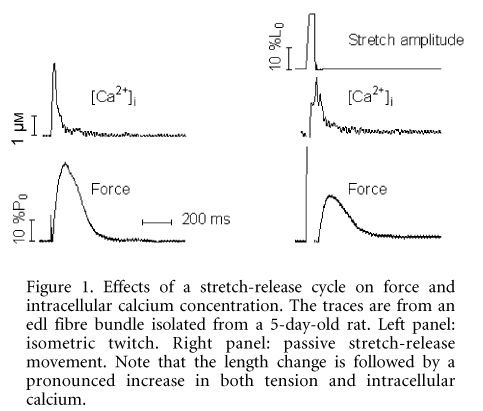Recent experiments have shown that a large triangular length change (> 20 % of initial muscle length, Lo) applied to a small resting muscle fibre bundle isolated from 7-day-old rats has two specific effects on passive tension (Mutungi & Ranatunga, 2001a, b). Thus in addition to the transitory passive tension response that accompanies the stretch, a twitch-like tension appears immediately after the stretch-release cycle. The latter is 30Ð50 % of the isometric twitch tension, and is only seen in neonatal rat muscle fibres. Except for results, such as the effects of BDM and dependence on sarcomere length (Mutungi & Ranatunga, 2001b) that suggest that the twitch-like response may be based on cross-bridge activity, the mechanisms underlying this phenomenon still remain unclear. The present experiments were aimed at investigating whether the twitch-like response to stretch is associated with intracellular calcium release.
The experiments were performed at 20 °C using small muscle fibre bundles (~10-15 muscle fibres) isolated from neonatal rats killed using carbon dioxide. Both soleus and extensor digitorum longus (edl) twitch muscles were used. Preparations were mounted horizontally between two stainless-steel hooks, one attached to a servomotor and the other to a tension transducer in a muscle chamber. After the initial length was set for optimum twitch tension, the preparation was subjected to a rapid stretch-release cycle (amplitude ~25 % Lo) and the tension and intracellular calcium levels monitored. The level of intracellular calcium was monitored using Fluo-3 AM following the procedure described by Caputo et al. (1994).
As Fig. 1 shows, the stretch phase was immediately followed by an increase in intracellular calcium and, after the completed stretch-release cycle, by a twitch-like tension response. Moreover, the amplitude of the stretch-induced myoplasmic calcium transient was smaller than that recorded during the control isometric twitch. Similar observations were made in all seven preparations (4 edl and 3 soleus) studied. These results demonstrate that a rapid stretch of muscle fibre bundles isolated from neonatal rats leads to an increase in intracellular calcium that causes activation of the contractile system.
This work was supported by grants from The Wellcome Trust and the Swedish Medical Research Council.
All procedures accord with current local guidelines and the Declaration of Helsinki.

